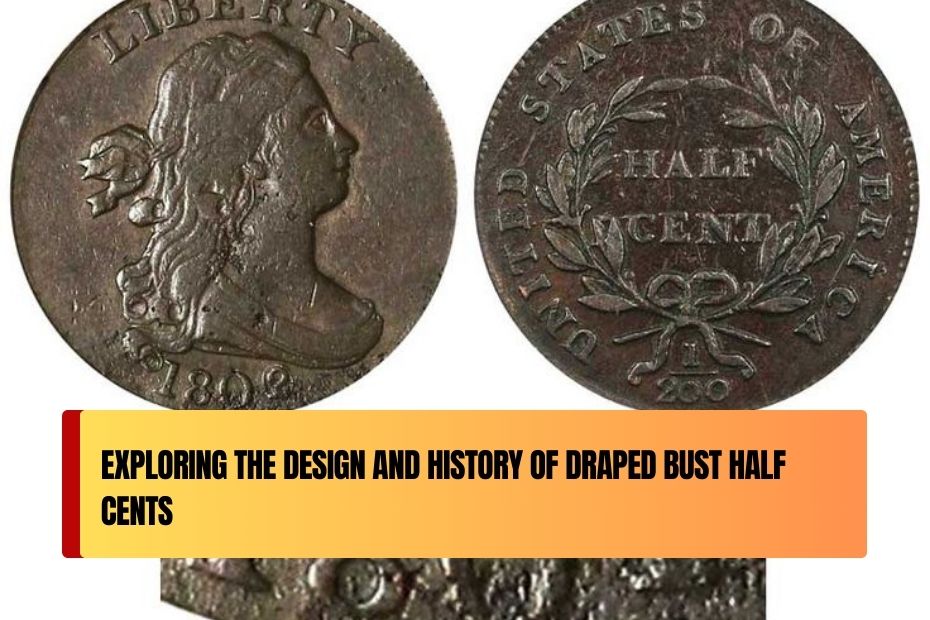The Draped Bust Half Cent is a fascinating coin with a rich history in American numismatics. Minted between 1800 and 1808, this small coin reflects the early years of the United States, showcasing the art and design of the era. In this article, we’ll explore the history, design features, and significance of the Draped Bust Half Cent. Whether you’re a seasoned collector or a newcomer to coin collecting, understanding the background of these coins will deepen your appreciation for their historical value.
History of the Draped Bust Half Cent
The Draped Bust Half Cent was introduced in 1800, during a time when the United States was still a young nation, struggling to establish itself. The coin was part of a broader effort to create a stable currency system for the country. At that time, half cents were primarily used for everyday transactions, making them important in the daily lives of American citizens.
The coin was designed by artist Robert Scot, who had previously created the designs for several U.S. coins, including the famous Liberty Head and Draped Bust designs. The Draped Bust Half Cent was the result of a request from the U.S. Mint to produce a small, easily recognizable coin that would serve as a lower denomination.
The Coin’s Design
The Draped Bust Half Cent features a distinctive design with a profile of Lady Liberty on the obverse and a wreath on the reverse. The obverse depicts Liberty with flowing hair, draped in a cloth, which gives the coin its name. Surrounding Liberty are the words “LIBERTY” and the year of minting.
On the reverse side, the design features an agricultural wreath surrounding the words “HALF CENT.” This was meant to symbolize the nation’s agrarian roots and emphasize the coin’s connection to the common people. The wreath is an important detail, adding both artistic beauty and symbolic meaning to the coin’s overall design.
Changes Over the Years
Although the basic design of the Draped Bust Half Cent remained the same throughout its production, there were small changes to the coin over time. In 1809, the design of the coin was changed, and the Draped Bust was replaced by a new design known as the Classic Head. This shift marked the end of the Draped Bust Half Cent series.
Despite the short production period, the Draped Bust Half Cent played an essential role in the early American economy. These coins circulated widely and were used for small transactions, particularly in rural areas.
Significance of the Draped Bust Half Cent
The Draped Bust Half Cent is not just a piece of currency; it’s a symbol of early American history. These coins were minted at a time when the country was still finding its place in the world. The design reflects both the artistic vision of the time and the nation’s identity, with its emphasis on Liberty and agrarian values.
Collectors value Draped Bust Half Cents because they represent a critical point in U.S. coinage. These coins were some of the earliest to be produced by the U.S. Mint and offer a glimpse into the early designs that shaped American numismatic history. Their rarity and historical significance make them highly sought after by collectors today.
Table: Key Facts About the Draped Bust Half Cent
| Feature | Details |
|---|---|
| Minting Period | 1800–1808 |
| Designer | Robert Scot |
| Obverse Design | Liberty with flowing hair, draped bust |
| Reverse Design | Agricultural wreath, “HALF CENT” inscription |
| Rarity | Relatively rare, especially in good condition |
| Material | Copper |
| Value Today | Varies by condition; can range from a few hundred to several thousand dollars |
Conclusion
The Draped Bust Half Cent is more than just a piece of currency—it’s a glimpse into early American history. From its artistic design to its role in the economy, this small coin played a significant part in the development of the nation’s coinage system. Though it was only minted for a short period, the Draped Bust Half Cent continues to be a beloved coin for collectors and historians alike. Whether you’re a numismatist or simply someone who appreciates American history, the Draped Bust Half Cent is a coin worth learning about.
FAQ’s
What is the Draped Bust Half Cent?
The Draped Bust Half Cent is a U.S. coin minted between 1800 and 1808, featuring Lady Liberty on the obverse and an agricultural wreath on the reverse.
Who designed the Draped Bust Half Cent?
The coin was designed by Robert Scot, who was also responsible for other early U.S. coin designs.
Why was the Draped Bust Half Cent discontinued?
The coin was replaced by the Classic Head design in 1809 as part of changes in U.S. coinage during that period.
How much is a Draped Bust Half Cent worth today?
The value of a Draped Bust Half Cent depends on its condition, with prices ranging from a few hundred to several thousand dollars.

